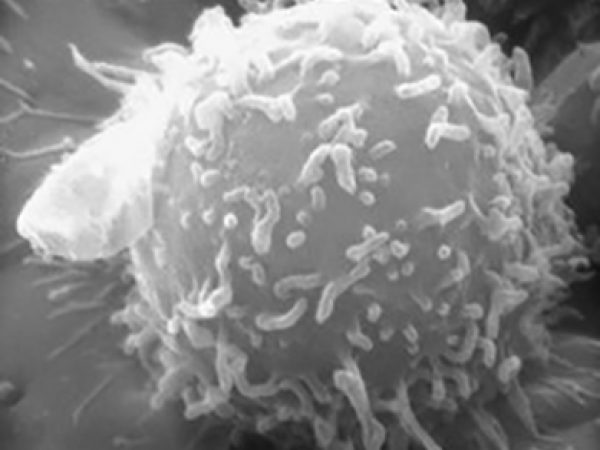Editors’ Picks for September
For September, the editors of the nine AACR journals have chosen to highlight a clinical trial that evaluated an Hsp90 inhibitor for the treatment of malignant pleural mesothelioma, a study that uncovered a potential therapeutic vulnerability for non-small cell lung cancer, and a study that identified a mechanism conferring resistance to PD-1 blockade, among other topics. As always, the featured articles are freely available online for a limited time.
Journal: Molecular Cancer Research
Even though patients with DNA mismatch repair-deficient (dMMR)/microsatellite instability-high (MSI-H) colorectal cancer tend to have better outcomes when treated with immune checkpoint inhibitors (ICI) compared with patients with MMR-proficient/microsatellite stable tumors, response rates can vary widely, suggesting underlying differences in this patient population. To learn more about these potential differences, the authors analyzed 222 dMMR/MSI-H and 1,400 MMR-proficient/microsatellite-stable tumors from patients with primary colorectal cancer. They identified a subgroup of patients whose dMMR/MSI-H tumors were characterized by the presence of a TGFβ-rich tumor microenvironment, high angiogenic activity, anti-inflammatory M2 macrophage polarization, and an extracellular matrix signature predictive of resistance to immune checkpoint inhibition. Among patients with dMMR/MSI-H colorectal cancer, those with TGFβ-rich stromal compartments had poorer survival outcomes on ICI regimens, which was independently validated in multiple cohorts. The authors conclude that dual inhibition of immune checkpoints and TGFβ signaling may enhance response rates in certain patients with dMMR/MSI-H colorectal cancer who are resistant to ICI alone. This article was highlighted in the September issue.
Journal: Molecular Cancer Therapeutics
While first-generation antibody-drug conjugates (ADCs) have shown clinical benefit for some patients with cancer, they are often limited by their narrow therapeutic window, which has been attributed to off-target toxicity caused by ADC instability. To overcome this limitation, the authors describe a next-generation, site-specific ADC that results in a constant drug-to-antibody ratio with a non-cleavable linker. This ADC, called ARX788, is comprised of a humanized HER2-targeting monoclonal antibody conjugated to the cytotoxic tubulin inhibitor monomethyl auristatin F (MMAF; AS269). When compared with the HER2 ADC ado-trastuzumab (T-DM1; Kadcyla) in a panel of cancer cell lines, ARX788 demonstrated superior activity in cell lines with low HER2 expression, with no activity in normal cardiomyocyte cells. Further, ARX788 generally outperformed T-DM1 in xenograft models with either low or high HER2 expression, and ARX788 treatment in breast and gastric cancer patient-derived xenograft (PDX) models resulted in tumor growth inhibition in both HER2-positive and HER2-low expression tumors, in addition to a T-DM1-resistant model. The authors conclude that ARX788 merits further development for the treatment of patients with HER2-positive breast and gastric cancer, including those whose tumors have developed resistance to T-DM1, or those whose tumors have low expression of HER2 and are therefore not currently eligible to receive HER2-targeted treatments. This article was highlighted in the September issue.
Journal: Cancer Research (September 15 issue)
BRG1 Loss Predisposes Lung Cancers to Replicative Stress and ATR Dependency

Roughly 10 percent of non-small cell lung cancers (NSCLC) are estimated to have mutations in the BRG1 gene, and patients with BRG1-mutant NSCLC have a poor prognosis, as their tumors often have limited responses to standard-of-care treatments. In this study, the authors investigated how BRG1 disruption affects lung cancer progression. In BRG1-deficient cells, the researchers observed increased origin firing, or the initiation of DNA replication at the replication origin, which was mediated by the protein CDC6, a member of the pre-replication complex. Additionally, through quantitative mass spectrometry and co-immunoprecipitation analyses, the researchers demonstrate that BRG1-containing SWI/SNF complexes interact with the ssDNA-binding protein RPA, suggesting that BRG1 may impact the function of RPA at replication forks. Evaluation of BRG1-knockout lung cancer isogenic models revealed slowed DNA replication, induction of replication stress, increased origin firing, and activation of the ATR checkpoint pathway. Finally, BRG1-mutant lung cancers were sensitive to pharmacological inhibition of ATR, both in vitro and in vivo. The authors conclude that inhibition of ATR for patients with BRG1-mutant cancers, or other BRG1-deficient cancers that exhibit replication stress responses, is a therapeutic strategy worth investigating. This article was featured on the cover of the September 15 issue.
Journal: Blood Cancer Discovery
The treatment of multiple myeloma with immunotherapeutic strategies that target B-cell maturation antigen (BCMA), including chimeric antigen receptor (CAR) T-cell therapy, have shown promise, yet most patients experience a relapse of their disease. One potential reason for relapse is the existence of a reservoir of multiple myeloma cells with no or low surface expression of BCMA. To combat this tumor antigen escape, the authors explored targeting an additional antigen that is highly expressed on the surface of multiple myeloma cells, G protein-coupled receptor class C group 5 member D (GPRC5D). The researchers compared three different forms of dual-targeted CAR T-cell strategies that target BCMA and GPCRC5D in a preclinical murine model of multiple myeloma: i) parallel-produced and pooled mono-targeted CAR T cells; ii) bicistronic constructs expressing distinct CARs from a single vector, resulting in two intact CARs on a single T cell; and iii) a tandem single-chain variable fragment (scFv) “single stalk” CAR design, which contains a bivalent, bispecific receptor. When targeting cells with BCMA-escape (which only expressed GPRC5D), the researchers found that the single-stalk CAR was less efficacious than both bicistronic CARs and pooled mono-targeted CARs, which had equivalent efficacy. However, bicistronic CARs were more efficacious than pooled mono-targeted CARs when targeting cells that expressed both BCMA and GPRC5D. The researchers conclude that bicistronic CARs avoid the challenge of parallel manufacturing of separate CAR T-cell products and display superior efficacy overall, suggesting that this dual-targeted approach may enhance the durability of response for patients with multiple myeloma. This article was featured on the cover and was highlighted in the September issue. A related commentary can be found here.
Journal: Clinical Cancer Research (September 1 issue)
The androgen receptor inhibitor apalutamide (Erleada) was approved to treat patients with nonmetastatic castration-resistant prostate cancer based on results from the phase III SPARTAN trial. While the addition of apalutamide to androgen deprivation therapy substantially reduced the risk of metastatic disease or death compared with androgen deprivation therapy plus placebo, the apalutamide combination was associated with higher rates of adverse events, which resulted in dose reduction in 21 percent of patients in that treatment arm. In this exploratory exposure-response analysis, the researchers analyzed the relationships between exposure to apalutamide and selected clinical and safety endpoints. Among patients who received apalutamide, differences in exposure to the drug or its active metabolite, N-desmethyl-apalutamide, did not result in clinical differences in metastasis-free survival. Further, higher apalutamide exposure was significantly associated with skin rash and weight loss. The authors therefore conclude that patients with these adverse events may benefit from a dose reduction without compromising the efficacy of apalutamide. This article was highlighted in the September 1 issue.
Journal: Cancer Research (September 1 issue)
Epigenetic CRISPR screens identify Npm1 as a therapeutic vulnerability in non-small cell lung cancer
Epigenetic regulators are proteins that interact with and/or modify chromatin and can contribute to cancer development and progression. Therapeutic targeting of epigenetic regulators has shown clinical activity for many cancers, but the therapeutic potential of targeting epigenetic regulators in non-small cell lung cancer (NSCLC) remains unclear. Here, the authors performed CRISPR screens in cell lines and in mice to identify potential epigenetic targets for lung cancer. The screen identified the histone chaperone nucleophosmin 1 (Npm1) as a potential target, and its deletion significantly reduced tumor progression in vitro and in vivo. Examination of patient data from The Cancer Genome Atlas showed that patients with NSCLC who had high Npm1 expression had lower overall survival. Further experimentation demonstrated that Npm1 depletion led to a metabolic change from aerobic glycolysis to oxidative phosphorylation and reduced the number of tumor-propagating cells. The authors conclude that Npm1 contributes to tumor progression in NSCLC and propose Npm1 as a potential therapeutic target. This article was featured on the cover of the September 1 issue.
Journal: Clinical Cancer Research (September 15)
Malignant pleural mesothelioma (MPM), which has been linked to asbestos exposure, is an incurable cancer that develops in the thin layer of tissue that lines the chest cavity and covers the lungs. Despite the increasing global mortality from this disease, effective therapies for first-line treatment are lacking; the standard-of-care treatment of pemetrexed and cisplatin yields a median progression-free survival of 5.7 months. Preclinical research has demonstrated that inhibition of the chaperone protein Hsp90 induces apoptosis and increases cisplatin antitumor activity in MPM. In this nonrandomized clinical trial, the combination of the Hsp90 inhibitor ganetespib with pemetrexed-platinum chemotherapy was evaluated in 27 patients with chemotherapy-naïve MPM. Among 23 evaluable patients, 61 percent had a partial response. Further, among 18 patients treated at the maximum tolerated dose of ganetespib (200mg/m2 on days 1 and 15 of each treatment cycle), 56 percent had a partial response, 83 percent had disease control (with one responder having disease control beyond 50 months), and the median progression-free survival was 6.3 months. The authors conclude that inhibition of Hsp90 in combination with pemetrexed-platinum chemotherapy should be investigated in larger randomized studies in patients with MPM. This article was highlighted in the September 15 issue.
Journal: Cancer Discovery
Inactivation of Fbxw7 Impairs dsRNA Sensing and Confers Resistance to PD-1 Blockade

Responses to PD-1 blockade can vary widely among different patients or even among different tumors within the same patient. To identify factors contributing to resistance, the authors of this study compared tissue samples of resistant and sensitive tumors from a patient with metastatic melanoma who had heterogeneous responses to anti-PD-1 therapy. They found that a resistant tumor had a loss-of-function mutation in the tumor suppressor gene FBXW7; this mutation was not found in a tumor that was sensitive to PD-1 blockade. The authors found that mouse tumor cells depleted of the Fbxw7 gene were resistant to anti-PD-1 therapy in mouse models. Furthermore, the loss of Fbxw7 was associated with changes to the immune microenvironment, decreased expression of the RNA sensors MDA5 and RIG1, and reduced expression of type I interferon and MHC-I. Restoration of RNA sensing in Fbxw7-depleted mouse cells was sufficient to sensitize these cells to PD-1 blockade. Together, the results indicate that inactivation of FBXW7 may confer resistance to PD-1 blockade through reduced RNA sensing and reduced immune activation. This article was highlighted and featured on the cover of the September issue.
Journal: Cancer Prevention Research
Prevention of tobacco carcinogen-induced lung tumor development by a novel STAT3 decoy inhibitor
Non-small cell lung cancers often have overactivation of the STAT3 signaling pathway, which contributes to carcinogenesis. Here, the authors examined whether STAT3 could be downregulated to delay or prevent lung cancer development. They tested a circular oligonucleotide STAT3 decoy (CS3D), which binds to STAT3 dimers to prevent their interaction with transcription targets, thus inhibiting downstream signaling. Mice that had been previously exposed to a tobacco carcinogen were treated with CS3D. The authors found that CS3D treatment reduced the development of airway preneoplasias by 42 percent at one week post-treatment, decreased the progression of preneoplasias to adenomas by 54 percent at eight weeks post-treatment, and reduced the size and number of lung tumors by 49.7 percent and 29.5 percent, respectively, at 20 weeks post-treatment. The observed chemopreventive effects were found to be independent of KRAS mutation status, and they were associated with reduced STAT3 signaling and lower numbers of immunosuppressive cells. The authors conclude that suppressing STAT3 signaling through the use of a decoy molecule reduced oncogenic signaling and immune suppression. This article was featured on the cover of the September issue.
Journal: Cancer Immunology Research
Tenascin-C Orchestrates an Immune-Suppressive Tumor Microenvironment in Oral Squamous Cell Carcinoma
Head and neck squamous cell carcinomas (HNSCCs) are associated with an immunosuppressive tumor microenvironment that is accompanied by changes to the extracellular matrix. Tenascin-C (TNC), a protein within the extracellular matrix, promotes inflammation and has been implicated in the progression of several cancer types. However, the impact of TNC on tumor immunity in HNSCC remains unclear. Here, the authors used a mouse model of oral squamous cell carcinoma to study the contribution of TNC. They found that TNC-deficient mice had fewer and smaller tumors compared with wild-type mice, increased tumor infiltration of dendritic cells, reduced expression of the CCL19 and CCL21 cytokines, and reduced tumor infiltration of T regulatory cells. Inhibition of the cytokine receptor CCR7 in wild-type mice diminished the immune-suppressive properties within the tumor microenvironment and reduced tumor number, progression, and lymph node metastasis. Together, the results implicate TNC in HNSCC disease progression. The authors propose inhibition of CCR7 as a potential therapeutic strategy for HNSCC. This article was featured on the cover of the September issue.
Journal: Cancer Epidemiology, Biomarkers & Prevention
Cancer registries are a resource that could be utilized to perform population-based epidemiologic studies of cancer survivors, but the feasibility of this strategy is unclear. In this study, researchers assessed the potential of using the National Cancer Institute’s Surveillance, Epidemiology, and End Results (SEER) Program registries to identify, recruit, and enroll cancer survivors. They examined six SEER registries of recently diagnosed and long-term survivors of early-age onset multiple myeloma, colorectal, breast, prostate, or ovarian cancer. Registered patients completed surveys to provide data on demographics, health, and willingness to participate in research studies. Of 992 total survey respondents, 90 percent were willing to complete a survey for a future research study, 91 percent said they would donate a biospecimen, and 82 percent said they would consent to having their medical records accessed for research. The authors conclude that SEER registries could be leveraged to recruit cancer survivors for research studies. This article was highlighted in the September issue.



